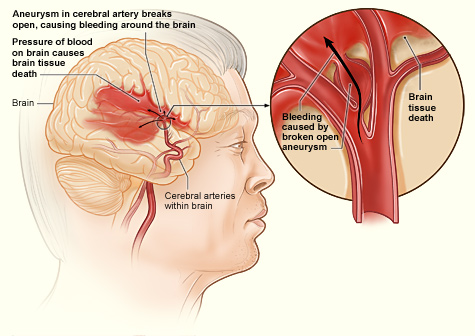- Fusiform. This is where the entire artery of the brain swells and bulges.
- Dissecting. This is a tear in the artery that causes leakage around the brain and braincase.
- Saccular. This is by far the most common type of brain aneurysm, accounting for approximately 90 percent. These aneurysms take the form of a sac that develops on the outside of the arterial wall. They can also be referred to as berry aneurysms, owing to the shape of the sac.
Drawing of the brain with a ruptured aneurysm, and the results.
The Warning Signs of Aneurysms
Some of the following symptoms make it easier to discern that there is something serious going on in your body, even though these are not exclusive to aneurysms. If you or someone around you experiences any of the following conditions, call an ambulance immediately.
- Numbness in one or both sides of your body.
- Unexplained weakness in one or both sides of your body, or even in a singular limb.
- Difficulty talking - unexplained slurred speech, or are not able to speak the words you are thinking.
- Dizziness or trouble walking, for no apparent reason i.e. intoxication.
- Seizures and convulsions.
- Unexplained loss of consciousness.
- Mild to severe headache.
- Mild to severe pain behind the eye.
- Pupil dilation.
- Double vision.
- Blurred vision.
- Nausea.
- Drooping eyelids.
So how do you differentiate between a brain aneurysm and just a normal headache or nausea? Unfortunately, there isn't a completely foolproof way to do so. For instance, if you only have nausea, it may be reasonable to assume you have a stomach bug. Therefore, a good strategy to use would be combinations. If you have nausea combined with double vision or numbness, or another symptom that is not common with a stomach bug, and you also have one or more of the aforementioned risk factors, you may want to go to the hospital.
Another example would be if you are experiencing pain behind the eye and light sensitvity, and have a history of migraines, it most likely is just a migraine. But if it is combined with difficulty speaking or trouble with walking, that is a definite red flag. Also, a headache that lasts more than a couple of days is often another telltale sign that something serious is going on.
